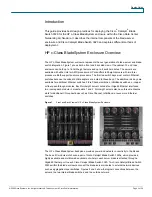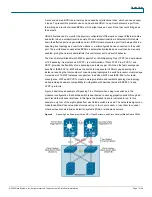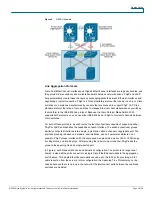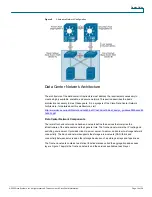
Design Guide
© 2008 Cisco Systems, Inc. All rights reserved. This document is Cisco Public Information.
Page 5 of 28
Cisco Catalyst Blade Switch 3020 for HP
This section briefly describes the Cisco Catalyst Blade Switch 3020 for HP and explains how the
blade servers within the HP c-Class BladeSystem are physically connected to the switching
modules.
The Cisco Catalyst Blade Switch 3020 provides enhanced Layer 2 services (known as Layer 2+ or
Intelligent Ethernet switching) to the HP c-Class BladeSystem. The Cisco Catalyst Blade Switch
3020 enhances basic Layer 2 switching by including Cisco proprietary protocols, access control
lists (ACLs), and quality of service (QoS) based on Layer 3 information. With Simple Network
Management Protocol (SNMP), command-line interface (CLI), or HTTP management options
available and a robust set of Cisco IOS
®
Software switching features, the Cisco Catalyst Blade
Switch 3020 naturally integrates into the data center environment. The following features highlight
this capacity:
●
Loop protection and rapid convergence with support for Per VLAN Spanning Tree Plus
(PVST+), IEEE 802.1w, IEEE 802.1s, Bridge Protocol Data Unit (BDPU) Guard, Loop
Guard, PortFast, UplinkFast, and Unidirectional Link Detection (UDLD)
●
Advanced management protocols, including Cisco Discovery Protocol, VLAN Trunking
Protocol (VTP), and Dynamic Trunking Protocol (DTP)
●
Port Aggregation Protocol (PAgP) and Link Aggregation Control Protocol (LACP) for link
load balancing and high availability
●
Support for authentication services, including RADIUS and client support
●
Support for protection mechanisms, such as limiting the number of MAC addresses allowed
or shutting down the port in response to security violations
Each Ethernet switch provides eight external Ethernet ports for connecting the blade enclosure to
the external network. Four Small Form-Factor Pluggable (SFP) ports provide 1000BASE-SX
interfaces and are shared with four of the copper Gigabit Ethernet links. Two additional copper
Gigabit Ethernet ports are shared with two internal crossover interfaces connecting the pair of
switches (labeled X-Crossovers in Figures 2 and 3). All of these ports can be grouped to support
the IEEE 802.3ad LACP. Each blade server is connected to the backplane using the available
Gigabit Ethernet network interface cards (NICs). The number of NICs on each blade server varies.
Each server, whether it is full- or half-height, supports an additional Ethernet interface providing
Integrated Lights Out (iLO) support.
Note:
The iLO interface supports a management interface that resides on each server blade. For
more information about the iLO system, refer to the “Management” section of this guide.






































